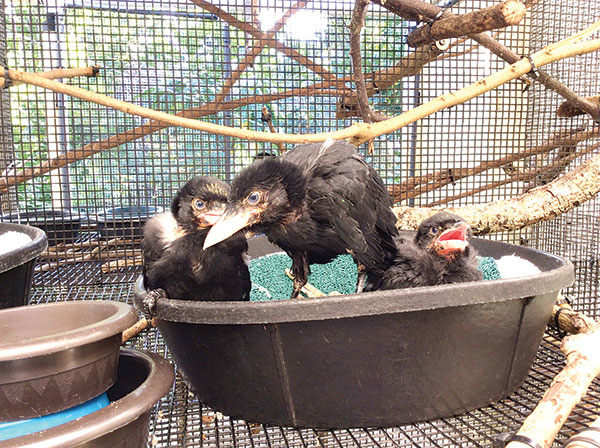5 Mariana crows to be released Friday
Photo shows reared Mariana crows while growing in a facility. The CNMI Division of Fish and Wildlife has re-set the release into the wild of five Mariana crows or aga on Rota this Friday. (DFW PHOTO)

(DFW PHOTO)
Due to damaged vegetation wrought by Typhoon Mangkhut on Rota, the CNMI Division of Fish & Wildlife has re-scheduled for Friday, Sept. 28, the first-ever release into the wild of five reared Mariana crows, which is the most critically endangered crow in the world.
DFW supervisor Jill Liske-Clark said the original date to release the crows, locally known as aga, was Sept. 13, but this was postponed due to Typhoon Mangkhut that hit Rota last Sept. 10.
The release of these crows into the wild on Rota is, according to Liske-Clark, a huge milestone in their captive rearing program.
That is why they are not providing the specific location of the release site, Liske-Clark said, to protect the birds. She would only say that it is public land on the east side of the island.
She said the place was selected because the forest provides quality habitat (even after Typhoon Mangkhut) and was formerly occupied by crows, but is currently unoccupied.
“The released crows will have less competition with wild crows to establish and defend territories,” she said.
Five more Mariana crows will be released next month.
Of the 10 birds that will be released, nine are females and one is male.
Liske-Clark said the ratio is purely by chance.
The University of Washington will be tracking the released crows for approximately one year after their release to ensure they are doing well in the wild.
Lands and Natural Resources Secretary Anthony Benavente and DFW director Manny Pangelinan both plan to attend the release on Rota but it will not be open to the public.
There are fewer than 200 Mariana crows left globally, all of them on Rota. The Guam population of the species was wiped out many years ago.
To prevent extinction, DLNR, the San Diego Zoo, University of Washington, and U.S. Fish and Wildlife Service initiated a captive rearing program on Rota two years ago.
“Eggs and chicks were taken from the nests of wild birds and brought into a facility for rearing, safe from predators, storms, and other events that cause failure of nests in the wild,” she said.
Liske-Clark said the first group of captive-raised Mariana crow are now 2 years old and are ready for release.
She said San Diego Zoo has been extremely successful in rearing Mariana crow in captivity, with all viable eggs hatched and 95 percent of all hatchlings surviving to independence.
Thirteen younger birds remain in captivity and will be released next year.
The population of aga has declined by about 50 percent since the 1990s, which prompted the decision to start the captive rearing program in 2016.
In 2014, for the first time in CNMI history, two captive Mariana crows, which were under the watch and care of the Rota Avian Behavioral Ecology Program, were released into the wild.




